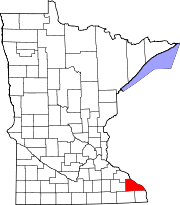Dakota, Minnesota
Dakota | ||
|---|---|---|
FIPS code 27-14518[5] | | |
| GNIS feature ID | 2393705[2] | |
| Website | cityofdakotamn.com | |
Dakota is a city in Winona County, Minnesota, United States. The population was 295 at the 2020 census.[3]
It is located between
Geography
According to the United States Census Bureau, the city has a total area of 0.98 square miles (2.54 km2); 0.65 square miles (1.68 km2) is land and 0.33 square miles (0.85 km2) is water.[6]
Dakota is located along the Mississippi River. Dakota Creek and the Mississippi River meet at Dakota. Nearby places include Winona, Dresbach, Nodine, La Crescent, La Crosse, Onalaska, and Great River Bluffs State Park.
Dakota is located 18 miles south of the city of Winona, and 11 miles north of the city of La Crosse.
History
Dakota was incorporated on May 23, 1951. It was laid out in 1855 and developed in 1859 by Nathan Brown, who came to Minnesota in 1847, had a stockyard, and ran a ferry service to Wisconsin. Once the center of berry growing, the main industry is now apple growing.[7]
Demographics
| Census | Pop. | Note | %± |
|---|---|---|---|
| 1880 | 81 | — | |
| 1960 | 339 | — | |
| 1970 | 369 | 8.8% | |
| 1980 | 350 | −5.1% | |
| 1990 | 360 | 2.9% | |
| 2000 | 329 | −8.6% | |
| 2010 | 323 | −1.8% | |
| 2020 | 295 | −8.7% | |
| 2021 (est.) | 291 | [4] | −1.4% |
| U.S. Decennial Census[8] 2020 Census[3] | |||
2010 census
As of the
There were 137 households, of which 28.5% had children under the age of 18 living with them, 58.4% were married couples living together, 5.1% had a female householder with no husband present, 2.9% had a male householder with no wife present, and 33.6% were non-families. 29.2% of all households were made up of individuals, and 8% had someone living alone who was 65 years of age or older. The average household size was 2.36 and the average family size was 2.92.
The median age in the city was 42.6 years. 22.6% of residents were under the age of 18; 4.4% were between the ages of 18 and 24; 26.6% were from 25 to 44; 34.1% were from 45 to 64; and 12.4% were 65 years of age or older. The gender makeup of the city was 53.3% male and 46.7% female.
2000 census
As of the
There were 130 households, out of which 31.5% had children under the age of 18 living with them, 63.8% were married couples living together, 5.4% had a female householder with no husband present, and 28.5% were non-families. 27.7% of all households were made up of individuals, and 16.9% had someone living alone who was 65 years of age or older. The average household size was 2.53 and the average family size was 3.13.
In the city, the population was spread out, with 28.9% under the age of 18, 5.5% from 18 to 24, 28.3% from 25 to 44, 19.5% from 45 to 64, and 17.9% who were 65 years of age or older. The median age was 37 years. For every 100 females, there were 93.5 males. For every 100 females age 18 and over, there were 91.8 males.
The median income for a household in the city was $50,156, and the median income for a family was $53,929. Males had a median income of $38,333 versus $24,375 for females. The
Transportation
Amtrak’s Empire Builder, which operates between Seattle/Portland and Chicago, passes through the town on BNSF tracks, but makes no stop. The nearest station is located in La Crosse, 10 miles (16 km) to the southeast.
References
- ^ "2020 U.S. Gazetteer Files". United States Census Bureau. Retrieved July 24, 2022.
- ^ a b U.S. Geological Survey Geographic Names Information System: Dakota, Minnesota
- ^ a b c "Explore Census Data". United States Census Bureau. Retrieved June 17, 2022.
- ^ a b "City and Town Population Totals: 2020-2021". United States Census Bureau. June 16, 2022. Retrieved June 17, 2022.
- ^ "U.S. Census website". United States Census Bureau. Retrieved January 31, 2008.
- ^ "US Gazetteer files 2010". United States Census Bureau. Archived from the original on January 12, 2012. Retrieved November 13, 2012.
- ^ Minnesota Place Names. Minnesota Historical Society. Accessed August 13, 2014.
- ^ "Census of Population and Housing". Census.gov. Retrieved June 4, 2015.

